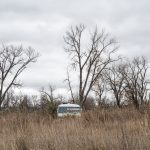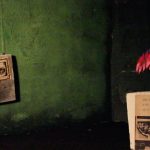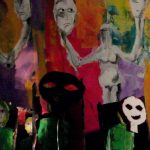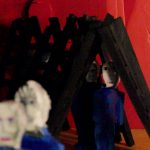


Hanif Abdurraqib is a poet, essayist, and cultural critic. His published work includes poetry in Muzzle, Vinyl, PEN America, and various other journals and essays and music criticism in The FADER, Pitchfork, The New Yorker, and The New York Times. His first full length poetry collection, The Crown Ain’t Worth Much (Button Poetry, 2016), was named a finalist for the Eric Hoffer Book Prize and was nominated for a Hurston-Wright Legacy Award. His first collection of essays, They Can’t Kill Us Until They Kill Us (Two Dollar Radio, 2017), was named a book of the year by Buzzfeed, Esquire, NPR, Oprah Magazine, Paste, The Los Angeles Review, Pitchfork, and The Chicago Tribune, and others. He is also the author of a poetry chapbook, Vintage Sadness (Big Licks, 2017), which was produced in a limited edition and is no longer available.
He is a Callaloo Creative Writing Fellow and a member of the poetry collective Echo Hotel with poet/essayist Eve Ewing. He now serves as poetry editor for Muzzle.
Yes, he would like to talk to you about your favorite band and your favorite sneakers. You can find out more at his website.
We caught up with Hanif at the Miami Book Fair in the fall of 2017, right before the release of They Can’t Kill Us Until They Kill Us to talk to him about that collection and The Crown Ain’t Worth Much.
Hunter Case for The Florida Review: I’m a little bit star-struck (laughter) and I’d like to have you start off by reading a poem.
Abdurraqib: Sure. This poem is called “None Of My Vices Are Violent Enough To Undo Remembering.” (Abdurraqib reads the poem, found here.)
TFR: The last couple of years have had you releasing a collection of both poetry and essays. Do you find it easier to go between the two forms? Or do you find you have a certain proclivity for one genre?
Abdurraqib: I’m actually at a point now where I don’t even think of genre as something that affects my approach to the work. I’m really driven instead by whatever it will take for me to figure out what’s latching onto me at the moment. Oftentimes, so much of my work is driven by my curiosities and knowing that I’m wrong about something. I’m interested in finding whatever avenue it takes for me—not even to find answers, but to find better ways to discuss my wrongness. Sometimes that’s a really long piece. Sometimes that’s a poem, sometimes it’s a combination of the two. But the sooner I gave up the idea of adhering to genre the easier the work came to me.
TFR: A lot of your poems are very narrative, or at least seem to be driven by some sort of distinct memory. I hope you don’t mind me asking this, but the ghost of the author’s mother and Tyler both play prominent roles in each collection respectively. And in “When We Were 13…” [a poem from The Crown Ain’t Worth Much], you say that a “piano can coax the most vicious of ghosts out of a body.” Do you ever find that your writing, or what you write, tends to do the same? That is the way of coaxing these ghosts out of your memory?
Abdurraqib: Yeah, or perhaps more efficiently, is that it’s a way of bringing people to life. Bringing people back to life I’ve lost. I think that’s important. I think that work is more vital than anything, which is why I don’t think of the work as sad when others might. I think of it as honoring—that it’s an honor for me to write about people who are no longer with me so that they might live on in a space that is outside of me. In a world beyond the one they inhabit while they are here.
TFR: You write so much about fear. The fear of loss, and there’s a fear of whiteness, blackness, violence. Do you ever find yourself being afraid of something in particular? What is the fear you find through your writing?
Abdurraqib: I’m afraid of the current state of the world. I’m afraid for the marginalized people I love. I’m afraid of empire and the way that America is positioning itself, not just in our States but globally. I’m afraid of all those things, and I believe that together we can work toward changing those things, but I’m even more afraid of the things I’m individually in charge of. I’m afraid of my anxiety overcoming my day-to-day life and not allowing me to live a life that chases some joy. I’m afraid of letting down the people I love in whatever way that looks like. And I’m afraid of not honoring and valuing the people I love while they’re still here to be honored and valued.
TFR: So since a lot of your writing is about honoring people, or being afraid of letting down people you care about, what is the most important part of that process? Getting those thoughts out? Living your life in that way?
Abdurraqib: The most important part of the process—for me at least—is trying to approach all of my relationships as honestly as possible. Trying to—and this is the real struggle—bring the vulnerability that exists on the page and bring the kind of honest tenderness that I attempt to bring to the page and bring that into my real life interactions. I think that’s hard work because it’s easy to write the thing, but it’s harder to live the thing sometimes. It’s easier for me to wax poetic about how I love my people and my work, but sometimes it’s harder to do that when I’m tired or frustrated. So I think the thing I’m working on endlessly is trying to live close to the way I write.
TFR: And do you think, coming from a masculine community, that tenderness is especially challenging to express on the page as well?
Abdurraqib: Yes and no. I will say this. A thing that I’m always aware of is the fact that I’m a straight, cis-male, so I am rewarded for showing vulnerability in ways that people who don’t identify like me are just expected to show vulnerability. Or that sometimes those who don’t identify as I do are punished for that vulnerability. I try to be very aware of that. Yes, vulnerability is a challenge for everyone. But all this stuff has to be seen through the lens of whatever privileges we hold. So I am cognizant of my vulnerability being applauded because of how I identify, but I also still earnestly chase after that because when I was young I didn’t have a real masculine blueprint for vulnerability, and what that led to was me growing up in a world in which I thought vulnerability was the work of women. I spent my late teens/early twenties in the punk scene, and I thought [vulnerability] was the work of my queer or women friends in the scene. And it’s not. So I want to work to strip that idea away, and I think it is stripping away honestly. I sometimes go into high schools and do workshops with students, and I think young men are really writing poems fearlessly and comfortably in a way that I wasn’t when I was their age because I was afraid of what writing a poem would mean. I was afraid of what writing a poem would tell me about myself. That if I put the emotions I was having down on the page that it would make them real and then I’d have to confront them. I think I’m seeing that in high schools—young men confronting those emotions in ways that I was not ready to.
TFR: And coming up in the scene that you did, did you ever get blow-back from attempting to get into writing—both as writing and as vulnerability—from anybody that you grew up with?
Abdurraqib: Not really, the most push-back I got was from being one of the few black kids in the scene. But I also came up in a particular era of punk/pop-punk/emo. The Myspace and AOL Instant Messenger era of the scene where everyone fancied themselves some kind of poetic person even though none of us were, right? The men who were the front-men of those bands, or the mouthpieces of those bands, were often the brooding writer types even though most of their writing was directed pretty poorly.
TFR: A lot of your writing talks about growing up in the Midwest. Both in the suburbs and out of them. Or, as you say, “the less than suburban neighborhood.” How do you think your writing and you, yourself, would be different had you not come up in the Midwest? Because I know that that scene—both the Midwest and its punk scene, similar to Chuck Klostermann who writes a lot about the Midwest metal scene—is very influential and very present in your writing. How do you think it would be different if you had grown up somewhere else?
Abdurraqib: I’m growing a little more interested in how I talk about the Midwest because post-election I feel the Midwest person became this one entity—this singular being—and there are as many types of Midwesterners as there are anyone. I was recently in Nebraska and that’s a very specific type of Midwest different from mine in Columbus, Ohio. I was in Omaha and Lincoln and those are very different Midwests, but there’s an ethos that I think has to do with facing your people. I’m not saying it doesn’t exist on the coasts, but I think that I am writing, always, as though I am in conversation with an audience already. I want people to come to my readings or see me read and feel like they have already joined a conversation in progress—or that they’re welcome to. I don’t know if I’d have that ability, or I’d have an eye towards that, if I did not grow up in a place where I felt like I was always a part of a conversation.
TFR: Do you feel that that critical distance is something that helps when you’re unlocking moments of tenderness? Or do you think you’d be impeded if you didn’t have that lens thinking of your audience when you approach the writing?
Abdurraqib: I feel like it’d be impeded. But I also think that my music writing, knowledge, and education was totally born just talking about music with my pals. In diners, in bars, in living rooms and basements. That’s what I’m trying to recreate. I don’t want there to be a world in which I am the critic and I am writing down to audience. My audience are the people I want to talk to about music, and I want to create that large living room where we can all sit and talk about some songs that we like. Or don’t like.
TFR: Is that recreation, besides being an egalitarian measure, maybe a nostalgia for those moments which might be gone otherwise?
Abdurraqib: I think there’s some nostalgia there. But I also think there’s an interest in that. I don’t think people anymore are interested in reading the critic-on-high telling them what to like or not like. A lot of people want to dive into the discussion and may not have time to be music writers for a living or may not have the passion. I did a reading recently and there were these two guys in suits, two businessmen who came to this reading, and they were so eager to talk to me during the Q&A about the piece I wrote on Fleetwood Mac. I’m interested in that person. The person who has a day job but also loves music and doesn’t have the opportunities to talk about it as much as they want to. They want to seek out someone who’s speaking to them on their level, where they feel a part of the conversation.
TFR: Jumping off of that, in They Can’t Kill Us, all of your essays are framed by these vignettes around Marvin Gaye. And his final performance at the NBA All-Star’s game before he died. His 1983 performance. Why did that feel right to you?
Abdurraqib: So there were a handful of things. One, it was the year I was born. Two, I had this interest in Marvin Gaye—the unpacking of that moment and how it could sing to every part of the book. Because it encapsulates everything: there’s fear there, triumph, violence.
TFR: There’s vulnerability.
Abdurraqib: There’s vulnerability. I’m fascinated by Marvin Gaye on the whole, but that was the one thing where I thought, Gosh, there’s so much of this and that singing to the collection, and it’s such a fascinating story because it’s this performance that he performed miraculously under a great deal of duress. And he was able to find this small bit of freedom in that performance. I think everything in that book is arcing toward freedom, at least as I see it. So it was natural for me to insert that throughout.
TFR: So, in the words of Marvin Gaye, “What’s going on?” With you, I mean.
Abdurraqib: (laughs) A lot. Just in general?
TFR: In general. Today.
Abdurraqib: Today’s great. I’m just overwhelmed by this. I got here this morning, maybe I should have come the night before. But I got here this morning, I had to fly out of Columbus at six in the morning. And I’m thrilled to be here, so many of my friends are here. I think the writing community I came up in is that there’s so many people I love and consider dear friends, but we sometimes only see each other at things like this. Or if we’re in each other’s towns for a bit, so this is like a small family reunion for me. I’m really thrilled.
TFR: Do you think that kind of atmosphere also captures the feeling of leaving your twenties, where your friendships fall to where you see each other occasionally? It almost parallels that arc.
Abdurraqib: Yeah, it arcs that way. I think adulthood is sometimes honing your long-distance communication skills. I think that’s it.
TFR: Each of these collections is structured—you said They Can’t Kill Us is structured around freedom. What do each of these collections mean to you, if they mean something different at all?
Abdurraqib: I don’t know if they mean anything different at all. I think they’re both archiving a certain thing. I think Crown is more specific in that it’s archiving a very specific brand of East Side Columbus, adulthood, and a very specific brand of black male childhood. I grew up watching films like Boyz n the Hood and Menace II Society, where I saw these black coastal narratives. So I think Crown was my attempt to kind of make Good Kid, M.A.A.D. City in book form for the Midwest. This portrait of a black childhood that is not entirely autobiographical—the bones of it, yes, but it’s not a memoir. I wanted to create a landscape and a storyscape that was like these things I grew up watching but specifically for my brand of Midwest.
TFR: The title, The Crown Ain’t Worth Much, what is the crown to you?
Abdurraqib: So the title comes from the TV show The Wire and the full quote is, “The crown ain’t worth much if the person wearing it is always gettin’ their shit taken.” For me, because so much of the collection is about the generational impacts of gentrification on the East Side of Columbus or Columbus in general, I began thinking the crown itself is any thing or any place you love and want to believe is yours. It’s something that can be taken as easily as it can be given, which I think is true of it in the traditional definition but also in this metaphor I crafted about land and home and freedom.
TFR: You said it’s semi-autobiographical, do you feel that your writing might portray you as having a more exciting life than you may feel you have?
Abdurraqib: Oh, absolutely.
TFR: (laughs)
Abdurraqib: I think that’s always the case. Crown, I wouldn’t even call it semi-autobiographical in some ways. I mean I think the most autobiographical stuff is maybe in that third section where I talk about the anxieties of preparing to be married and all of those things. But, a lot of it is the bones of my life with more complex, newer, better flesh on top of them. The stuff that’s in They Can’t Kill Us is way more personal. Way closer to home. And of course, you’re always worried about how you portray yourself more than anyone else. I think I did okay.
TFR: I saw in an interview that you’re working on a second collection of poems. Are there any forms or topics that you haven’t had a chance to write about yet that you are excited to experiment with?
Abdurraqib: Topics-wise, I feel like I wrote a very large political book with Crown. I know it might not seem political because we weren’t in this “political moment.” But I think I may be picking an interesting moment in time to want to write about the minutiae of living. When I first moved back to Columbus, there was a tree outside my apartment, and the way the sun would hit it in the morning the shadow of a leaf would move across my bed and eventually end up on my face. I’m fascinated by that. I want to write about several small mercies as they come to me. I know that might not seem as impressive now because people are expecting the now-more-than-ever book. We need poets to be political now more than ever but, I think that for me, as a black person in America, my now has been now for a long time. So I’m interested in exploring that which will get me through.
TFR: While I think it’s important to speak about the grand narrative, you can also lose a lot if you don’t focus on the personal moments. It’s almost as though you can sometimes forget how to live.
Abdurraqib: Absolutely.
TFR: Before the interview, we were talking about Fall Out Boy and their importance in They Can’t Kill Us, and I wanted to ask you: if you could tell Pete Wentz something both pre-hiatus and post-hiatus, what would you say?
Abdurraqib: I’ve actually told him something post-hiatus. In short, I told him, through someone, that the new songs aren’t for me, but I’m glad to see that the band is still affecting young people in a good way. I went to go see them on the back of the American Beauty/American Psycho tour and I just thought that album was a nightmare to listen to, but I wanted to see them. It’s a different type of young person, but I don’t want to dismiss that. Pre-hiatus, it depends on which Pete, right? Because pre-hiatus there were four different Petes. There’s a Pete for each album. The Pete that’s most interesting to me is the Infinity on High Pete who was struggling with the idea of fame. He really wanted to be famous, but didn’t really want fame. Because now, Pete Wentz is mega-famous, he adjusted. But the whole band break-up was because he couldn’t adjust, he married Ashlee Simpson. I guess I don’t know this for a fact, but it seems like the whole tension between that last album pre-hiatus was because he couldn’t [adjust.] I think Infinity on High is their greatest album, but I think it’s the album where, as a writer, Pete is seeing through a lot of his tricks. He’s just writing plainly about this intense agony—and as I wrote about them in They Can’t Kill Us. I saw early Fall Out Boy shows—I saw the first Fall Out Boy show ever. It has to be a very specific kind of pain to come up in the Chicago hardcore and emo scene, to be Pete Wentz in that scene. To be beloved in bands like Race Traitor and Arma Angelus, playing to thirty people who were his best friends; to go from that to playing VH1 for Paris Hilton overnight. They put out From Under the Cork Tree, thought it would be fine, and then “Sugar, We’re Going Down Swinging” becomes this massive hit. That had to be a real pain, where the band would play in Chicago and his friends couldn’t get into the show, or to have people from his scene, that he was in bands with, calling them “sell-outs.” My heart broke for that Pete Wentz. That writing scene means so much to me, I can’t fathom what it would be like to be so successful that it harms my relationship to it.
TFR: I love talking music and, given your writing, I know you do too. If you could make our readers a mixtape, who would be on it?
Abdurraqib: It’s hard to make a universal mixtape. A mixtape is a story, and you have to build a narrative, so I like leading off with songs that are haunting. I would probably lead off with “Devil Town,” the Bright Eyes version, because I don’t think the Daniel Johnston version is that compelling. I would put “Crazy” by Kehlani because that’s a really fun song. Cat Power has a cover of the Velvet Underground’s “I Found a Reason” which I think is maybe the best cover of anything, ever. I’m just fascinated by Cat Power. There’s a piece on them that was cut from the book—I don’t think it should have been cut from the book, I wish I could put it somewhere else. I’d put some Otis Redding, you can’t go wrong with any Otis Redding. Anderson Paak. But if I put Anderson Paak, I also have to put A Tribe Called Quest because I think it’s good to put an artist and the lineage they come from. This could go on forever. I would put Fall Out Boy. Generally, if I’m making a mixtape for somebody, I’ll end it with Fall Out Boy’s “Saturday.” It’s the great closer.
TFR: Similarly, if you could have a “poet mixtape.” Not generally, but for you, who would be on it?
Abdurraqib: Oh, Angela Veronica Wong, who’s one of my favorite writers. Sam Sax. Safia Elhillo. Courtney Lamar Charleston. And Nate Marshall. William Evans, who’s my mentor from Columbus. Terrance Hayes. Kaveh Akbar. Franny Choi. Cameron Awkward-Rich. Ocean Vuong. Anne Sexton. Frank O’Hara. Gosh, I could go on.
Oh, Adrian Matejka. Sorry, that’s the last one.
TFR: (laughs). I read in a previous interview with you that you always manage to feel like an artist, even when you aren’t producing. I know that that can be a struggle for a lot of writers, myself included. Any tips on how to keep yourself from being self-critical and feeling inadequate if you don’t produce constantly?
Abdurraqib: I think the answer is imagining the work living as the work. This society—because of capitalism and how it bleeds into the art world—is so obsessed with what we can produce and how much we’re producing when really the production is an ongoing thing. If I go out tonight and have a conversation that moves me closer to the unearthing of something that has been nested inside, or that allows me to see the world in a way that’s a tiny bit richer, that is also work. That’s also art. If I wake up tomorrow morning, look out my hotel balcony, and see a bird diving into the water and that motion brings to mind some poetic movement I haven’t been able to figure out yet, that’s also work. It’s not only work if I run to go write it down immediately—the witnessing is work. Conversation, laughter, and song, all of these things that sit inside of us and push us on a path towards whatever eventual art may exist that comes from us, or others, that’s all the art, too. So you’re an artist when you’re doing these things. You’re an artist when you’re consuming that which opens you up to something refreshing or new. You’re an artist when you’re enjoying a meal alone. You’re an artist then, too.
TFR: What advice would you have for writers, in general? Not just about self-doubt, but just about writers, for writers.
Abdurraqib: I think read twice as much as you write. That’s been my thing since the beginning. I read way more than I write. I guess this isn’t universal advice, because sometimes the people you love to read might be too busy to talk to you, but find the writers you love and don’t be afraid to reach out to them and ask them who they’re reading. That’s how I built my poetry canon. I asked the writers I admired who they admired, or what books they loved. Because I don’t have an MFA, I didn’t really start taking poems seriously until around 2011.
TFR: Do you have a favorite piece from either of your collections? Or both?
Abdurraqib: In They Can’t Kill Us, “Fall Out Boy Forever” means a lot to me. I don’t know if it’s the best piece. It’s the longest thing in the book by, at least, 3000 words. It was one of those things that lead to a lot of self-discovery. I also really like the piece on My Chemical Romance and feel good about the piece with Whitney Houston and Michael Jackson kissing.
TFR: From The Crown?
Abdurraqib: I like the first poem in the book, “On Hunger.” It’s the first poem I wrote for the book, and it’s an effective thesis statement for the book.
TFR: To echo what you said earlier, it’s very haunting, which is a good way to start off a mix.
Abdurraqib: I sequenced that book as though I was making a mix. I think that piece is probably my favorite.
TFR: Your author bios on your publications always say that you want to talk about music, love, and sneakers. So, what is your favorite sneaker and do you think it means anything that you were born right before Air Jordans came out?
Abdurraqib: Probably. (laughs) Although, the first couple of ones were pretty bad. I think my favorite sneaker of all time is the third sneaker: the Jordan 3. It’s just very clean and comfortable. It fits my foot really well in the way that some don’t because it’s a little wider. My foot’s a little wider. It just looks good with any pair of pants. Sometimes the thing about shoes is how they look with pants, and I think Jordan 3’s look good with every pair of pants. They’re not complicated, there are some Jordans that are complicated, like Jordan 6’s. The design is so muddled. The Jordan 11—those are beautiful with the patent leather on them, but it is just not a practical shoe. But I would say that the Jordan 3 is my favorite.
















